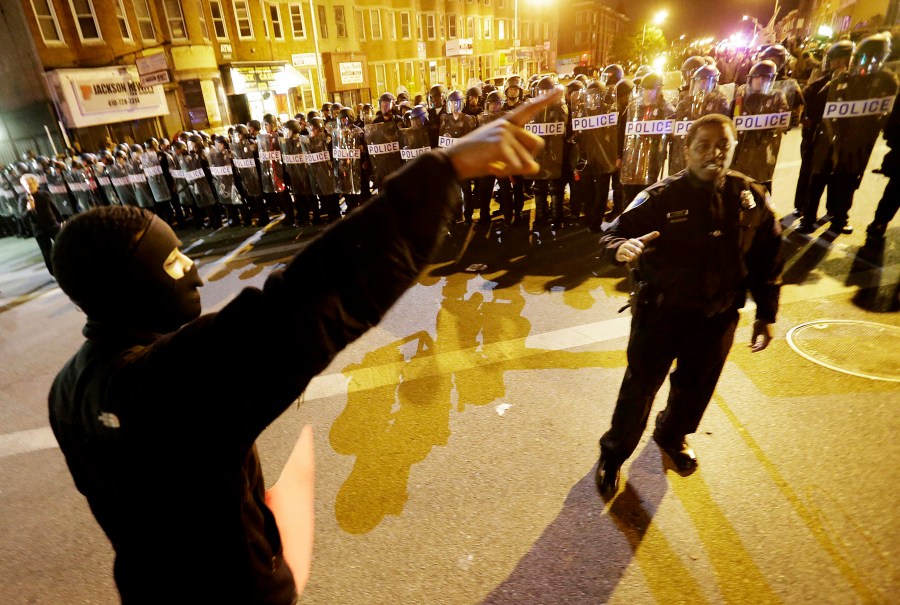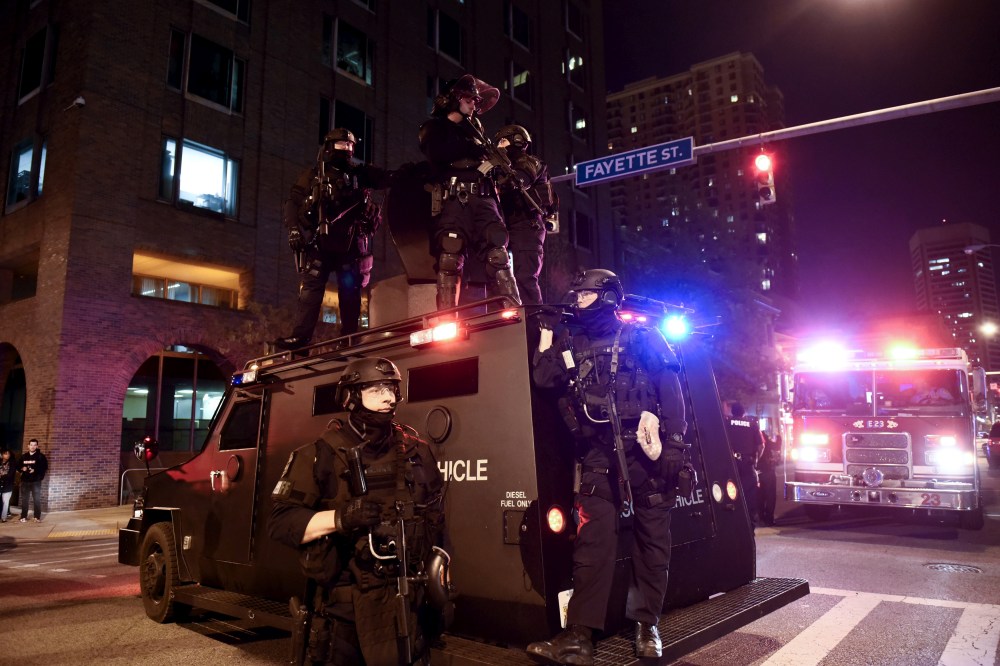The columns of police in riot gear — bulging rubber chest and leg armor and full helmets with see-through facemasks — moved forward, gripping plastic shields and night sticks as they chanted in unison: “Move! Move! Move! Move!” Behind them, three armored personnel carriers followed.
A helmeted man protruded from the turret of the middle vehicle as all three crept forward, inches at a time. One long block further down West North Avenue, another row of city police in full riot gear stood waiting. The police commissioner, Anthony Batts, in full regalia, inspected the line as the blue-red-blue-red whirl of police lights interrupted the low white glow of street lamps. Military Humvees festooned the street and police and news choppers buzzed overhead.
It looked like a military exercise. Or perhaps a military occupation.

When the police column advanced, it met a line of about a dozen civilians, consisting of more than twice as many media photographers as protesters. The image of riot police versus the Fourth Estate could easily have passed as farce. Most of the few remaining protesters had stayed behind after curfew to do media interviews. They were scattered across the star-shaped intersection talking into television cameras and posing for photographs. The small number of die-hard stragglers, defying the 10 p.m. emergency curfew, moved onto the sidewalk near the Enoch Pratt Free Library, a sleek, modern building that local residents said mostly houses transients during the day in ordinary times, when drug dealing, not protests, is what happens on the corner.
Earlier in the night, a pair of young teenage boys had wheeled back and forth on a bicycle, one propped on the kickstand, alternately removing and replacing the bandanas over their faces, defying and taunting the police. But now they were gone, having cycled away into the darkness of the battered neighborhood before the military-style column formed, without warning, about a half hour into the curfew. In the end, one man was arrested, and the police lines fell back, casually returning to their earlier post along the wall of the Arch Social Club, an ornate building across from the library that from its founding in 1905 had served as the outlet for middle class black Baltimoreans separated from society by segregation and hate.
Afterward, the public information officer said the show of force had literally been for the media – intended to move the reporters and their cameras onto the sidewalk, so that police could tell the journalists from the curfew violators.
‘God has answered our prayers’
Just an hour before, the intersection had been filled with democratic activity: vigorous protests, passionate encounters between constituents and their civic leaders. A group of young men grilled a local law enforcement official charged with community relations. As Rep. Elijah Cummings, the Democratic congressman tried to explain the process that the state attorney was going through to obtain justice for Freddie Gray, black men in hoodies and in sport jackets, mothers gripping the hands of young children, and twenty-somethings declaring “Black Lives Matter” were demanding to know why, as of Thursday night, none of the six officers involved in Gray’s April 12 arrest — which ended with him in a coma, and dead one week later with a nearly severed spinal cord — were in jail.
Less than twenty-four hours later, they were, though all quickly bonded out, leaving six grim-faced mugshots rocketing through social media and across television and cable news.

Three of those charged were, like Freddie Gray, African-American. Officer Caesar R. Goodson Jr., the wagon driver and a 17-year veteran of the force, faced the most serious charges, including “second degree depraved heart murder,” for repeatedly ignoring Gray’s pleas for medical help as he made multiple stops with Gray shackled but un-seatbelted in the back of a transport van. Officer William Porter, who observed Gray on one of those stops and yet failed to render aid, and Sgt. Alicia White, who upon observing Gray “unresponsive on the floor of the wagon, “spoke to the back of Mr. Gray’s head” and failed to offer any help when he did not respond, each faces charges of manslaughter and misconduct in office.
The other three were white. Officer Garrett Miller, Officer Edward Nero and Lt. Brian Rice, all members of the city’s bike patrol unit, were accused in the indictments of stopping Gray illegally and detaining him without establishing probable cause. The folded knife that Miller’s police report said was found in Gray’s inside front pants pocket, and which he recorded as an illegal switchblade, was no switchblade at all, Maryland State Attorney Marilyn Mosby said in announcing the charges Friday. The three officers face charges of assault, false imprisonment, misconduct in office, and in Rice’s case, involuntary manslaughter.
As word of the charges and the warrants issued for the officers’ arrest filtered out into the city’s predominantly black east and west sides Friday morning — and in the city’s northwest district, where Freddie lived and where poverty is as stark as the rows of abandoned buildings with boarded up windows — there was elation.
After a week of turmoil and unrest in the city, including a flash of fires and looting on Monday, the day of Freddie Gray’s funeral, it seemed to many like a miracle. One protester, a teacher who had decided on Tuesday to do the one thing she could think of — hold a sign every day, standing in front of the now infamous burned-out CVS, demanding justice for Freddie Gray — by Friday night was donning a new sign that read: “God heard our prayers.”
Scars left by a week of turmoil and uncertainty
The week had left its scars on the city, whose downtown hotels were left half empty by mass cancellations, and which ceded millions of dollars in foregone revenue from shuttered restaurants, bars forced by the curfew to close early, and an empty pro baseball stadium; and on Baltimore residents, who watched their city become the latest American municipality to become synonymous with the brutality visited on black bodies by police.

Some of the wounds were more personal. Students at Frederick Douglass High School had been accused by many in the media of starting the Monday riots after their and nearby high schools emptied into the transit hub near Mondawmin Mall as they did nearly every day. Douglass students and other black residents were still seething from being labeled “thugs” by the city’s African-American mayor, Stephanie Rawlings-Blake, who later retracted her words, and by the first black president of the United States.
And of course, at the center of it all was Gray’s family, left one person short, just two months before what would have been Freddie’s 26th birthday.
The week had also cast a shadow over Rawlings-Blake, who was being criticized from every corner for waiting too long to ask for help from the state, for the city’s decision to close schools on Tuesday, leaving Baltimore’s 85,000 students with nothing to do, and for not being visible in the communities that were hurting the most, long before Freddie Gray died.













